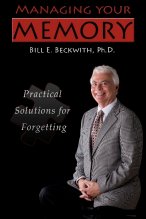What Should I do if I am Risk for Alzheimer’s Disease: Part IV
The foundation of any cognitive wellness program consists of evaluation, long-term planning, and goal setting. Cognitive wellness also requires a lifelong commitment to exercise. In addition, cognitive wellness is further enhanced by managing short-term memory, remaining cognitively stimulated, and social.
Short-term memory failure is usually the culprit for senior moments as well as the first sign of diseases such as Alzheimer’s disease. Short-term memory is not a time but rather the process by which the brain learns new information such as a new name or a change of address.
There are two basic causes of forgetting involving short-term memory. First, you will not remember if you don’t pay adequate attention. New information does not get attended to well enough in situations like multi-tasking or stress and fatigue. This is like attention deficit disorder. Second, the short-term memory system in the brain weakens after a stroke, a head injury, or the development of progressive dementias such as Alzheimer’s disease.
The solution to fixing short-term memory is the One Minute Rule. Anything given less than one minute of thought will fade from your memory. That’s why we take notes, use Post-its, repeat names, and use reminder tones on cell phones. It’s the whole point of mnemonics. These are strategies that allow us to better attend to and to encode new information so we can remember it better in the future as short-term memory cannot be exercised. Once these strategies become habits, they protect us against weakening of short-term memory circuits in the brain. The trick for treating short-term memory loss is having the habits in place before you need them. With progressive short-term memory loss you live better as a result your habits, skills, and memory supports as you have to live more and more in the moment.
Long term memory consists of knowledge (the capital of Florida, the planets in the solar system), skills (swimming, using a microwave, playing Bridge, doing crossword puzzles), personal history (birth date, address, and social security number), habits (writing appointments in your calendar, brushing your teeth). Long-term memory is built through repetition and practice. It works like a muscle in that the more you work it the stronger it becomes. You build long term memory by engagement and stimulation (go to museums, use in “brain fitness” programs, reading, taking courses, attending concerts, etc).
In short, don’t just leave your memory or your future to chance. Plan on how you will remember. Plan to have a good life, even if you can’t remember it. Treating progressive dementia requires a long range plan that includes financial, legal, medical, and cognitive/memory components that are most effective if they are in place before you need them. Alzheimer’s disease unfolds over decades and responds well to early treatments that add quality to life whether your memory remains intact or declines as you age.




